To layer effectively for winter cycling, start with a snug base layer made of moisture-wicking materials like merino wool or synthetic fabrics to keep sweat away from your skin. Add an insulating mid layer such as fleece or merino wool for warmth, then cover everything with a windproof and waterproof outer shell. Don’t forget to layer your legs, hands, and feet appropriately, and adjust your layers during your ride to stay comfortable. If you want to learn more about perfecting your winter layering, keep exploring essential tips and strategies.
Key Takeaways
- Use a moisture-wicking base layer to keep sweat away from your skin and prevent chilling.
- Add an insulating mid layer like fleece or merino wool for warmth and moisture management.
- Choose a windproof and waterproof outer layer to shield against wind, rain, and snow.
- Layer your extremities with thermal gloves, wool socks, and insulated shoe covers for full protection.
- Adjust ventilation using zippers and vents to regulate temperature and prevent overheating during activity.
Understanding the Importance of Layering in Cold Weather Cycling
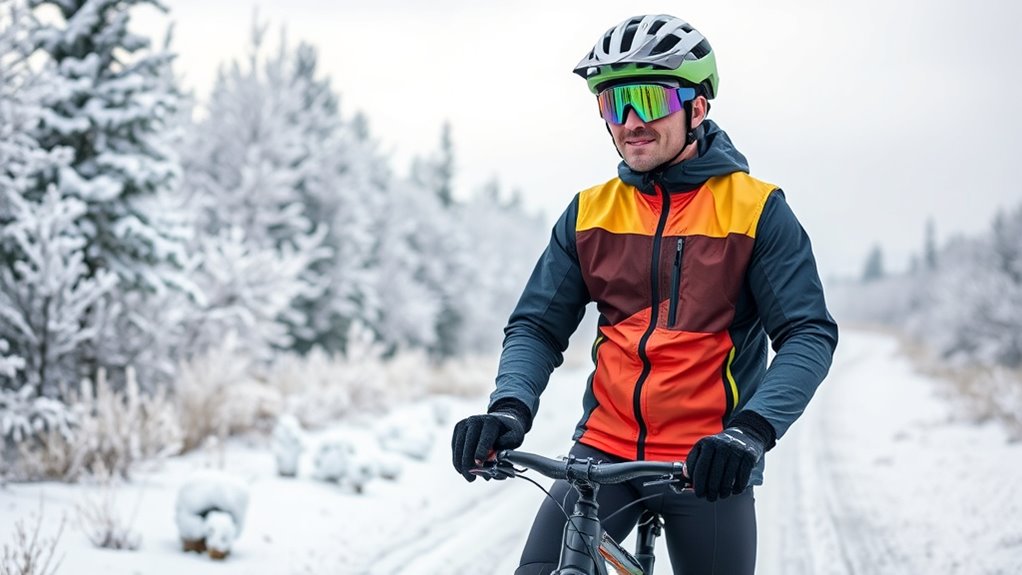
Layering is essential for staying warm and safe during winter cycling because it helps trap heat close to your body while allowing sweat to escape. Your base layers play a critical role by wicking moisture away from your skin, keeping you dry and warm. An effective outer layer shields you from wind and water, maintaining your core temperature during rides. When you choose the right outer layer, you prevent heat loss and stay comfortable even in harsh conditions. Proper layering prevents overheating during exertion and avoids cold-related issues when resting. Each layer has a specific function—base layers manage moisture, mid-layers insulate, and outer layers block the elements—so combining them strategically maximizes warmth and safety during winter cycling.
Selecting the Right Base Layer for Moisture Management
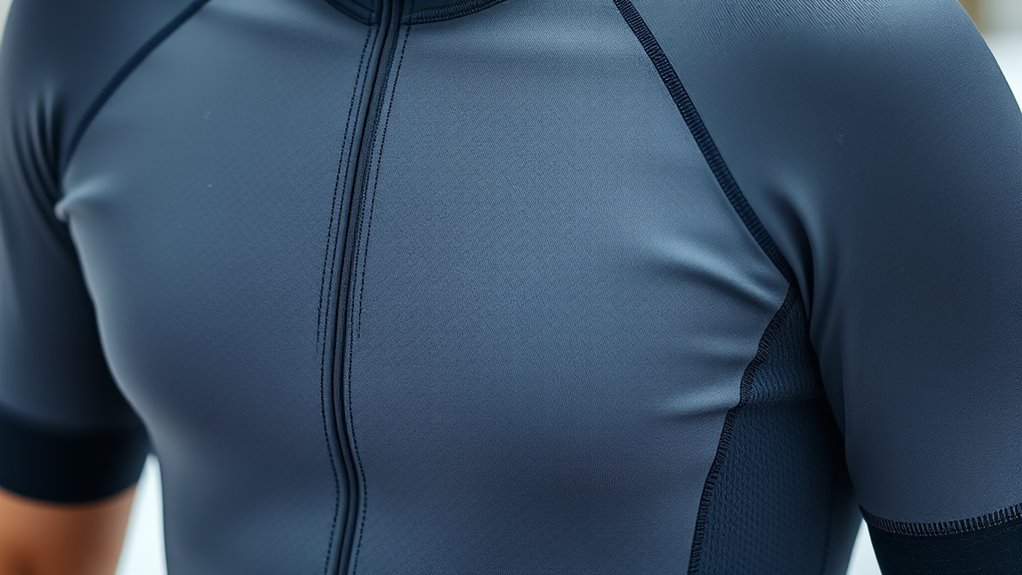
Choosing the right base layer is crucial for effective moisture management during winter cycling. Your goal is to wick sweat away from your skin to stay dry and warm. Consider these options:
- Merino wool offers excellent moisture management, even when wet, and resists odors, making it a natural favorite.
- Synthetic fabrics like polyester or polypropylene dry quickly and are highly durable, ideal for intense rides.
- Avoid cotton, as it absorbs moisture without wicking, increasing heat loss and discomfort.
- Make certain your base layer fits snugly but isn’t restrictive, maximizing skin contact to improve moisture transfer and thermal regulation.
- Remember that data privacy challenges and the ethical considerations surrounding algorithmic data usage highlight the importance of choosing materials that support reliable moisture management, ensuring your comfort and safety during long winter rides.
Choosing Effective Mid Layers for Insulation and Comfort
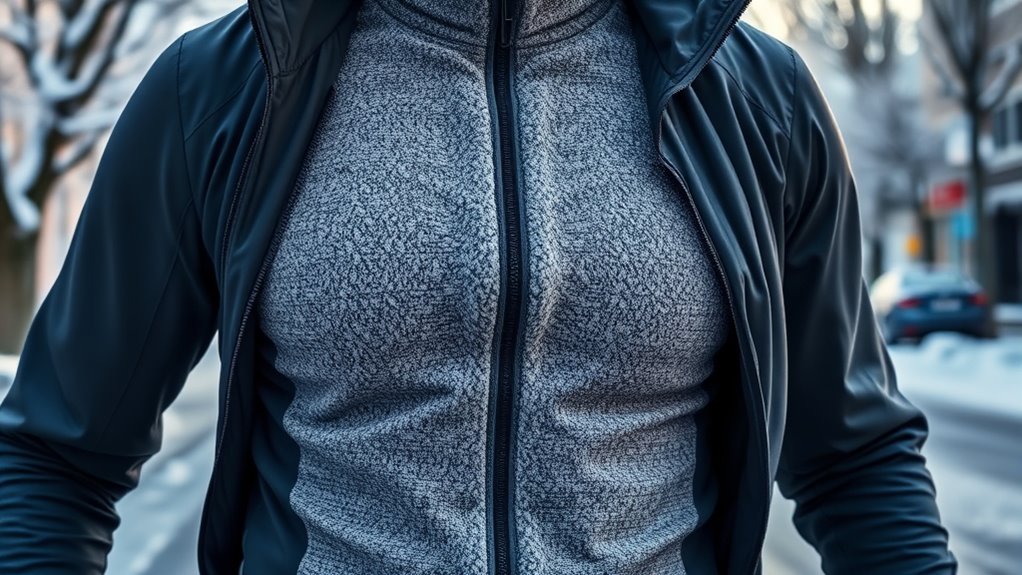
Selecting the right mid layer is essential for maintaining warmth and comfort during winter cycling, especially in cold conditions below 45°F. You want an insulating fabric like fleece, merino wool, or synthetic downs such as PolarTech, which traps warm air and provides effective thermal regulation. A good mid layer should also have moisture-wicking properties to move sweat away from your skin, preventing chill and discomfort during intense efforts. Opt for a fleece or merino wool jersey that balances warmth and breathability. The fit should be slightly loose to create air pockets for insulation while still fitting comfortably under your outer shell. Incorporating thermal properties like these enhances insulation efficiency and helps regulate body temperature in cold weather. Using layering techniques effectively allows you to adapt to varying conditions and stay comfortable throughout your ride. Combining a moisture-wicking base layer with an insulating mid layer ensures you stay warm, dry, and comfortable throughout your ride. Additionally, choosing fabrics with textile options like crochet or knitted fabrics can also add an extra layer of insulation and style to your winter cycling gear. Implementing modern fabric technologies can further improve moisture management and insulation performance.
Picking the Appropriate Outer Layer to Block Wind, Rain, and Snow

To stay dry and comfortable during winter rides, you need an outer layer that effectively blocks wind, rain, and snow. Choose outer layers like windproof jackets and softshells that shield you from wind chill while maintaining breathability. Waterproof shells with high Poray ratings (10,000 or higher) keep rain and snow at bay, ensuring you stay dry even in heavy precipitation. Layering a wind-resistant outer shell over insulated mid-layers traps heat while allowing moisture to escape. Look for jackets with adjustable vents, zippers, and strategic fabric zones to regulate temperature and prevent internal moisture buildup. Incorporating innovative materials such as those used in Nike Tech can further improve your gear’s performance in adverse weather conditions. Additionally, selecting fabrics with advanced waterproofing technologies can provide extra protection against the elements. Employing proper layering techniques helps optimize thermal regulation and moisture management during winter cycling, especially when considering the importance of tire pressure for maintaining grip and comfort on snowy or icy roads. Proper layering not only enhances comfort but also contributes to overall safety in winter riding conditions.
Tips for Layering Your Legs, Hands, and Feet for Maximum Warmth
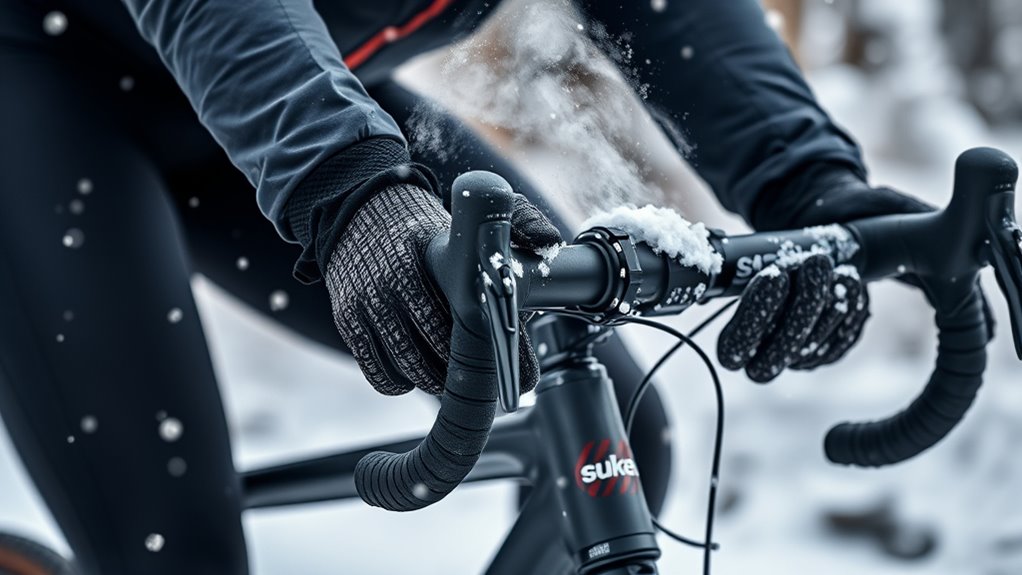
Keeping your legs, hands, and feet warm during winter rides requires strategic layering that balances insulation with mobility. Start with a moisture-wicking base layer under thermal tights or bibs to keep sweat away from your skin. Add knee or leg warmers for extra insulation and flexibility. For your feet, wear wool socks inside insulated overshoes or shoe covers, which trap heat and block cold air. On your hands, use glove liners beneath insulated gloves or mittens for added warmth. Here’s a quick guide:
| Body Part | Base Layer | Insulation/Outer Layer |
|---|---|---|
| Legs | Moisture-wicking | Thermal tights + leg warmers |
| Feet | Wool socks | Insulated overshoes |
| Hands | Gloves liners | Insulated gloves or mittens |
This setup helps maximize warmth without sacrificing mobility. Additionally, choosing high-quality insulation layers can further improve your comfort during cold rides.
Recognizing Common Mistakes in Layering and How to Avoid Them
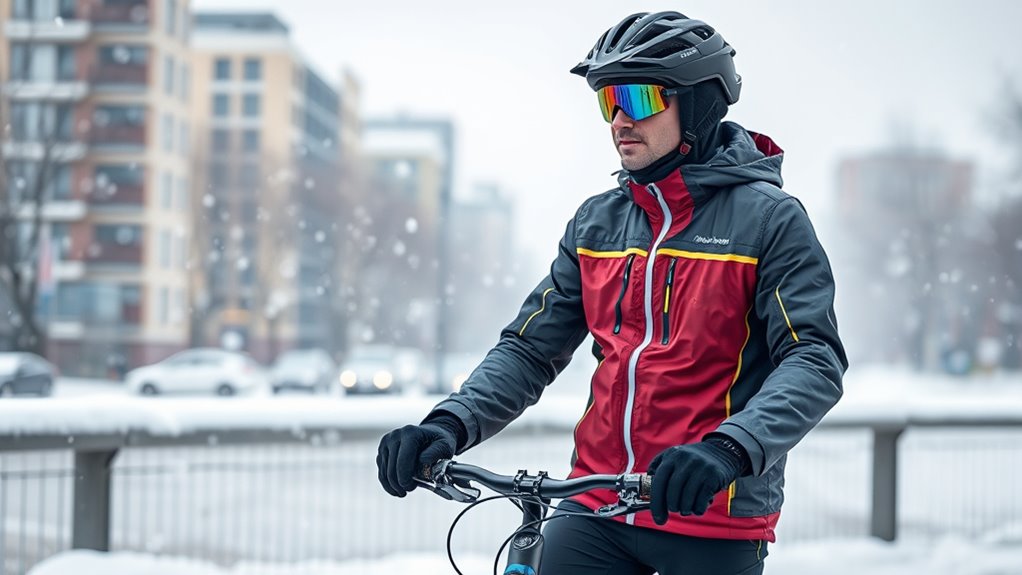
Many cyclists make the mistake of over-layering, which can cause you to sweat excessively and overheat. This moisture buildup reduces insulation and increases hypothermia risk. To avoid this, consider these common mistakes:
- Using cotton or heavy materials in base layers that hinder moisture wicking and dry slowly, leaving you cold.
- Relying solely on a bulky outer layer, limiting flexibility and adaptability to weather changes.
- Failing to incorporate breathable fabrics or venting options in outer layers, trapping sweat and moisture.
- Not adjusting layers during your ride, risking overheating or chilling as conditions change.
Adjusting Layers During Your Ride for Changing Conditions
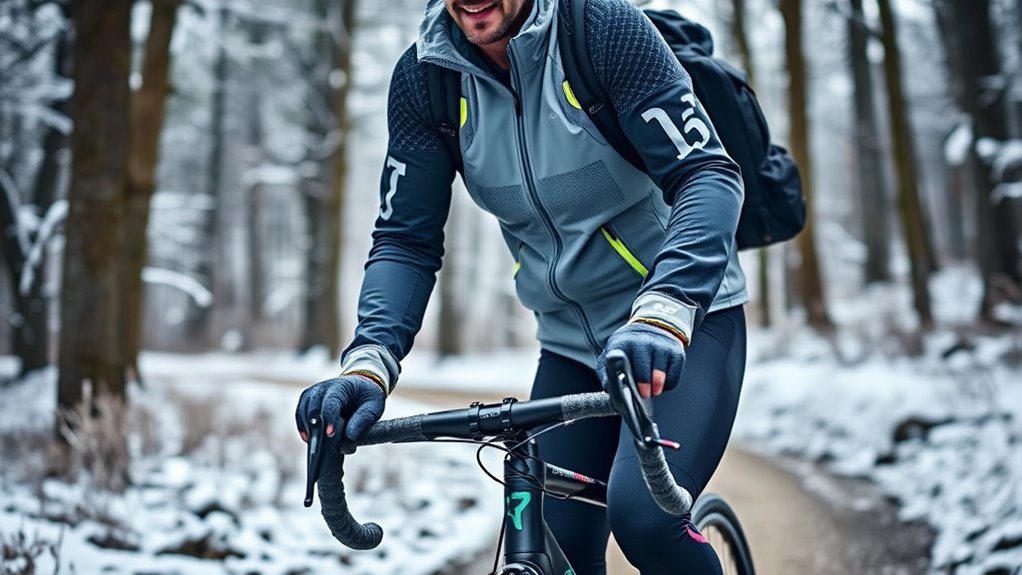
As the weather shifts, you need to adjust your layers to stay comfortable and safe. Use vents, zippers, or unzipping outer layers to release heat when you start sweating or feel too warm. Keep an eye on your body’s signals so you can quickly add or remove layers to maintain the right temperature. Practicing layering techniques ensures you’re prepared for varying conditions during your ride. Incorporating personal data and data-driven strategies can help you better understand your personal comfort zones and optimize your layering for different weather patterns. Additionally, understanding how sound vibrations influence bodily responses can inform your awareness of physical cues during your ride.
Venting Strategies for Comfort
Adjusting your vents during a winter ride is key to maintaining comfort as conditions change. Proper ventilation prevents overheating and excessive sweating, which can lead to chills. To optimize airflow: 1. Use vent zippers on jackets and jerseys to open or close for quick temperature regulation. 2. Engage mesh panels to enhance passive ventilation without sacrificing warmth. 3. Adjust adjustable vents on outer layers to increase airflow when you’re exerting more effort. 4. Target underarm or side zippers for precise, localized ventilation without removing layers. 5. Recognize that air quality can serve as a subtle sign from the universe guiding you toward better emotional and spiritual balance, just as adjusting vents helps maintain physical comfort. Incorporating essential oils into your routine can also support your well-being, providing aromatherapy benefits that promote relaxation and alertness during rides. Practicing these strategies helps you respond to shifting conditions, keeping your core temperature stable. Remember to monitor how you feel and make timely adjustments to your vent zippers and vents, ensuring comfort and efficiency throughout your ride.
Monitoring Body Temperature
Monitoring your body temperature during a winter ride helps you stay comfortable and avoid overheating or chilling. Regularly check your body temperature by feeling your neck, wrists, or forehead to determine if you need to add or remove layers. Use moisture-wicking baselayers to stay dry and quickly adapt your layers with zippers, vents, or easily accessible clothing like arm warmers. Pay attention to signs of overheating, such as sweating excessively or feeling clammy, and remove outer layers promptly to prevent chilling. If you start feeling cold or notice numbness in your extremities, add insulation layers or windproof garments to maintain core warmth. Making these quick adjustments ensures your layers work effectively, keeping your body temperature regulated and your ride comfortable no matter the conditions.
Environmental Considerations and Eco-Friendly Layering Choices
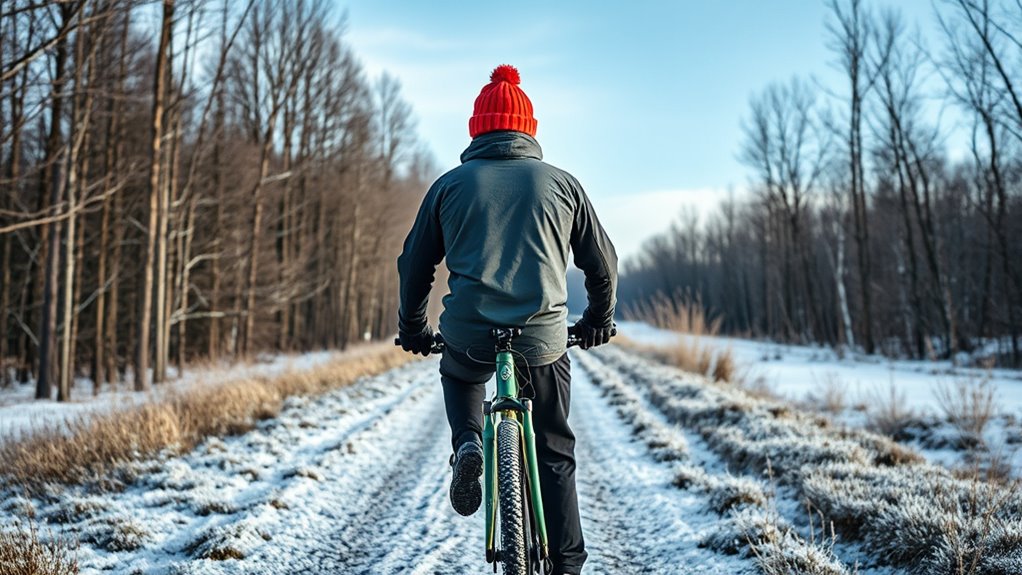
When choosing layers for winter cycling, consider fabrics like recycled polyester, organic merino wool, or hemp to lessen environmental impact and reduce microfiber pollution. Selecting durable, multi-purpose clothing helps cut waste and lowers resource use over time. By supporting brands with eco-friendly manufacturing practices, you can enjoy staying warm while protecting the planet.
Sustainable Fabric Options
Choosing sustainable fabrics for winter cycling not only keeps you warm but also minimizes environmental impact. Eco-friendly fabrics like recycled polyester, merino wool, and Tencel offer excellent alternatives to traditional materials. Recycled polyester, made from post-consumer plastic bottles, reduces waste and conserves resources. Organic merino wool is produced without harmful chemicals, promoting eco-friendly farming practices. Tencel, derived from sustainably harvested eucalyptus trees, is biodegradable and moisture-wicking. When selecting fabrics, consider these options:
- Recycled polyester for durability and environmental benefits
- Merino wool for natural warmth and sustainability
- Tencel for softness, moisture management, and biodegradability
- Other eco-friendly fabrics that support microplastic reduction
Choosing these materials helps you stay warm while supporting environmentally responsible cycling gear.
Reducing Microfiber Shedding
Microfiber shedding from cycling apparel can substantially contribute to microplastic pollution in our waterways, harming aquatic life and ecosystems. To reduce this, choose eco-friendly fabrics like merino wool or low-shedding synthetic blends instead of regular polyester. Proper layering techniques also help; avoid excessive layers and opt for garments with reinforced or low-shedding fabrics. Using laundry filters or specialized washing bags captures microfibers before they reach water systems. Supporting brands that prioritize sustainable, low-shedding fabrics encourages eco-friendly choices. Here’s a visual guide:
| Fabric Type | Shedding Level | Best For |
|---|---|---|
| Merino Wool | Low | Base layers, insulation |
| Eco-friendly blends | Low | Mid-layers |
| Traditional polyester | High | Outer shells, liners |
Eco-Friendly Manufacturing Practices
Eco-friendly manufacturing practices are transforming how winter cycling gear is produced by prioritizing sustainability and reducing environmental impact. You’ll find brands using recycled materials, such as recycled polyester and nylon, in base layers and outer shells to lower resource consumption. They also employ low-impact dyes and non-toxic chemicals, which cut pollution and conserve water. Additionally, manufacturers are adopting biodegradable fibers and microplastic-free textiles to minimize microfiber shedding and microplastic pollution. Certifications like OEKO-TEX Standard 100 and GOTS verify that these products meet strict environmental and social standards. To choose eco-conscious gear, look for these features, as they ensure your layering not only keeps you warm but also supports sustainable practices. This approach helps protect ecosystems while providing high-performance winter cycling apparel.
Practical Gear and Accessories to Enhance Your Layering System
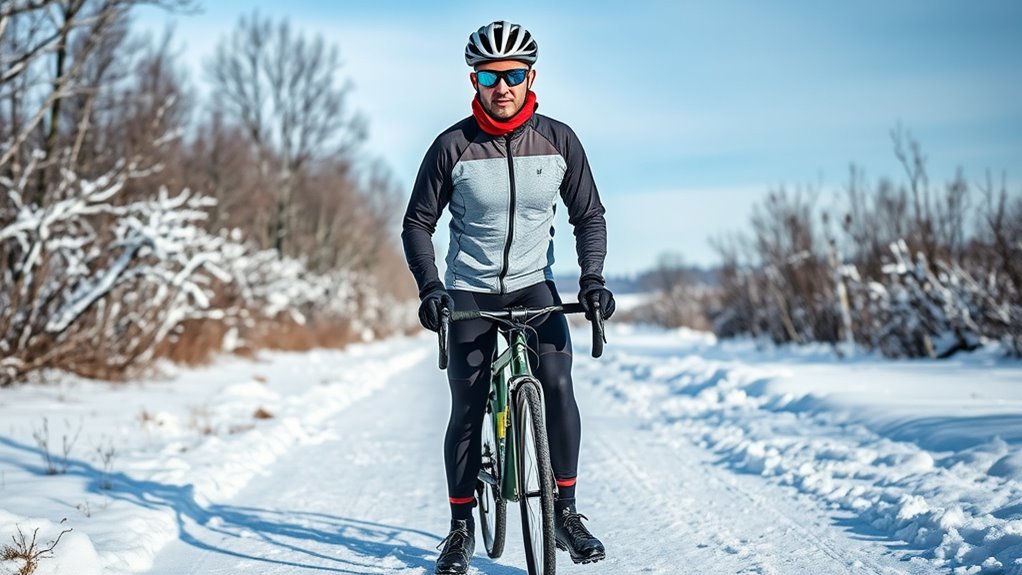
To effectively stay warm and protected during winter cycling, you should incorporate practical accessories that complement your core layers. These items prevent heat loss and improve comfort without adding bulk. For example, thermal headbands and neck buffs shield your head and neck from wind and cold, while layered gloves—thin liners combined with insulated or waterproof outer gloves—keep your hands dexterous and warm in varying conditions. Shoe covers with thermal lining and waterproofing protect your feet from ice and wetness. Additionally, waterproof jackets or gilets block wind and rain, allowing moisture to escape. Incorporating reflective accessories, like vests or armbands, boosts visibility. Here’s a quick overview:
| Accessory | Purpose |
|---|---|
| Thermal headbands | Wind and cold protection |
| Gloves | Maintain dexterity and warmth |
| Shoe covers | Keep feet dry and warm |
| Waterproof jackets | Block wind and rain, vent moisture |
Strategies for Staying Safe and Comfortable in Varying Winter Conditions
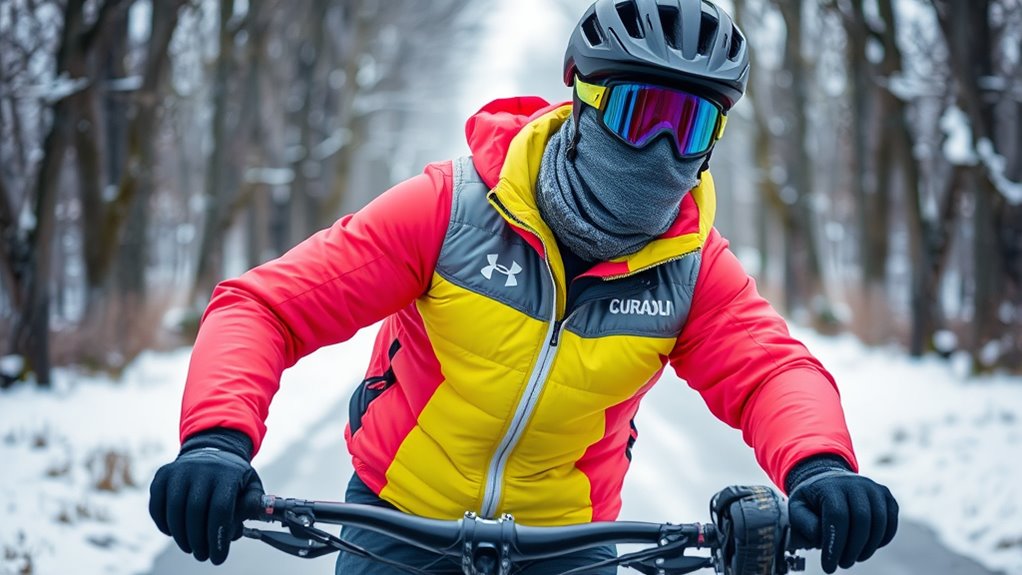
To stay safe and comfortable, you need to adjust your layers as weather and effort change during your ride. Protect your extremities with proper gloves and footwear to prevent frostbite, especially in cold, windy conditions. Choosing weather-ready gear that’s breathable, windproof, and moisture-wicking helps you adapt quickly and stay comfortable no matter what winter throws at you.
Layer Adjustments During Rides
Adjusting your layers during a winter ride is essential for maintaining comfort and safety as conditions change. Pay attention to how your body feels, especially regarding sweat and temperature. Here are key strategies:
- Use zippers and vents to increase airflow and cool down when you overheat during intense efforts.
- Remove or add layers quickly, carrying easily accessible options like jackets in your handlebar bag.
- Monitor external cues like wind chill or precipitation, adjusting your outer layers to prevent heat loss or moisture buildup.
- Keep your core warm, as maintaining torso heat helps regulate blood flow to extremities, reducing the need for excessive layer adjustments on hands and feet.
Protect Extremities Effectively
Keeping your extremities warm is essential for both safety and comfort during winter rides, especially when conditions are harsh. To protect your extremities, layer appropriately—use insulated gloves with liners and outer shells to maintain warmth and dexterity. Thin liners add extra insulation during extreme cold. Insulating shoe covers, like neoprene or layered overshoes, create a barrier against wind and cold, preventing toes from freezing. Cover your face with balaclavas or neck buffs under your helmet to shield exposed skin from wind chill and frostbite. Heated accessories, such as battery-powered hand and toe warmers, provide additional warmth during long rides. Ensuring a snug but comfortable fit for all layers maximizes insulation and blood flow, reducing the risk of numbness and frostbite.
Weather-Ready Gear Choices
Choosing the right gear for changing winter conditions can make or break your ride. To stay safe and comfortable, focus on selecting weather-appropriate gear and layered outerwear that balances warmth and breathability. Here are key strategies:
- Use layered outerwear with high breathability ratings, like jackets with Poray ratings above 10,000, to manage moisture effectively.
- Carry versatile outer layers, such as windproof vests for mild cold and waterproof jackets for heavy rain.
- Add accessories like thermal gloves, face masks, and waterproof shoe covers to protect extremities.
- Adjust your outer layers based on weather forecasts—adding insulation during cold snaps and venting during milder, active rides.
These choices help prevent hypothermia, regulate body temperature, and ensure a safe, enjoyable ride in varying winter conditions.
Frequently Asked Questions
What Is the Best Base Layer for Cycling in Winter?
You want the best base layer for winter cycling, and that’s usually merino wool or a synthetic blend like polypropylene-polyester. Merino wool keeps you warm, resists odors, and stays insulating even when wet, while synthetic fabrics dry quickly, are lightweight, and durable. Avoid cotton, as it absorbs moisture and makes you cold. Choose a snug, lightweight, long-sleeve or short-sleeve layer based on your temperature needs for maximum comfort.
What Is the 75 Rule in Cycling?
Did you know your core temperature should stay above 75°F for safe winter cycling? The 75 Rule helps you stay warm by emphasizing the importance of maintaining that temperature. It’s a practical guide, not a strict rule, reminding you to monitor weather and adjust your layers accordingly. By doing so, you prevent hypothermia, fatigue, and loss of coordination, ensuring you ride comfortably and safely even in cold conditions.
How to Layer for Winter Riding?
When layering for winter riding, start with a moisture-wicking base to keep sweat away from your skin. Add a mid-layer like fleece for insulation, then top with a windproof or waterproof outer shell to block wind and rain. Adjust layers as needed during your ride by venting or removing them. Make sure each layer fits well, snug but comfortable, to stay warm, dry, and agile in winter conditions.
What Do You Wear When Cycling in the Winter?
When cycling in winter, you need to be prepared for anything Mother Nature throws your way. Wear a moisture-wicking base layer to stay dry, add an insulating mid-layer like fleece or lightweight down for warmth, and top it with a windproof, waterproof shell. Don’t forget thermal gloves, a neck buff, and insulated footwear—cover your bases so you’re not caught out in the cold. Staying layered keeps you riding strong all season long.
Conclusion
Layering for winter cycling is like building a fortress against the cold. By choosing the right layers and adjusting them as you go, you’ll stay warm, dry, and safe no matter how the weather shifts. Think of your gear as a trusted crew, working together to keep you comfortable on every ride. Master this system, and winter won’t be able to freeze your riding spirit—your adventure ready to bloom even in the coldest months.
















